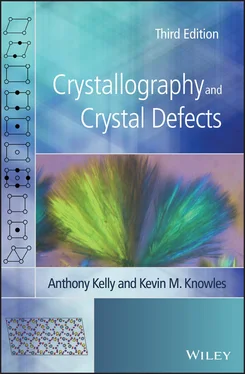Anthony Kelly - Crystallography and Crystal Defects
Здесь есть возможность читать онлайн «Anthony Kelly - Crystallography and Crystal Defects» — ознакомительный отрывок электронной книги совершенно бесплатно, а после прочтения отрывка купить полную версию. В некоторых случаях можно слушать аудио, скачать через торрент в формате fb2 и присутствует краткое содержание. Жанр: unrecognised, на английском языке. Описание произведения, (предисловие) а так же отзывы посетителей доступны на портале библиотеки ЛибКат.
- Название:Crystallography and Crystal Defects
- Автор:
- Жанр:
- Год:неизвестен
- ISBN:нет данных
- Рейтинг книги:3 / 5. Голосов: 1
-
Избранное:Добавить в избранное
- Отзывы:
-
Ваша оценка:
Crystallography and Crystal Defects: краткое содержание, описание и аннотация
Предлагаем к чтению аннотацию, описание, краткое содержание или предисловие (зависит от того, что написал сам автор книги «Crystallography and Crystal Defects»). Если вы не нашли необходимую информацию о книге — напишите в комментариях, мы постараемся отыскать её.
explains the modern concepts of crystallography in a clear, succinct manner and shows how to apply these concepts in the analyses of point, line and planar defects in crystalline materials.
Fully revised and updated, this book now includes:
Original source references to key crystallographic terms familiar to materials scientists Expanded discussion on the elasticity of cubic materials New content on texture that contains more detail on Euler angles, orientation distribution functions and an expanded discussion on examples of textures in engineering materials Additional content on dislocations in materials of symmetry lower than cubic An expanded discussion of twinning which includes the description and classification of growth twins The inclusion and explanation of results from atomistic modelling of twin boundaries Problem sets with new questions, detailed worked solutions, supplementary lecture material and online computer programs for crystallographic calculations. Written by authors with extensive lecturing experience at undergraduate level,
continues to take its place as the core text on the topic and provides the essential resource for students and researchers in metallurgy, materials science, physics, chemistry, electrical, civil and mechanical engineering.


 (≡ 3/ m ) is placed in this system because of the use of rotoinversion axes to describe symmetry operations of the second sort; 6,
(≡ 3/ m ) is placed in this system because of the use of rotoinversion axes to describe symmetry operations of the second sort; 6,  , 6/ m and 6 mm show no diad axes, just like their counterparts in the tetragonal system. The crystal axes for 6 mm are usually chosen to be perpendicular to one set of mirrors (they then lie in the other set) and
, 6/ m and 6 mm show no diad axes, just like their counterparts in the tetragonal system. The crystal axes for 6 mm are usually chosen to be perpendicular to one set of mirrors (they then lie in the other set) and  m 2 could be developed as
m 2 could be developed as  m (≡ 3/ mm ). The diads automatically arise and are chosen as crystallographic axes. Of course, 622 contains diads. It could be developed as 62, since the second set of diads arises automatically (see Table 1.2). The axes are chosen parallel to one set of diads. Only 6/ m and 6/ mmm are centrosymmetric in this system.
m (≡ 3/ mm ). The diads automatically arise and are chosen as crystallographic axes. Of course, 622 contains diads. It could be developed as 62, since the second set of diads arises automatically (see Table 1.2). The axes are chosen parallel to one set of diads. Only 6/ m and 6/ mmm are centrosymmetric in this system. l ), for example (11
l ), for example (11  1). It is convenient to choose a ( hh
1). It is convenient to choose a ( hh  l ) plane because such a plane is equally inclined to the x ‐ and the y ‐axes.
l ) plane because such a plane is equally inclined to the x ‐ and the y ‐axes. l ) pole is seen to be given by:
l ) pole is seen to be given by:

 ) pole
) pole l ) is:
l ) is:
 1}, {10
1}, {10  1} and {12
1} and {12  1} indicated for a hexagonal cell is shown in Section 2.6in connection with crystals of the trigonal system. The special forms in the various classes of the hexagonal system are listed in Table 2.1.
1} indicated for a hexagonal cell is shown in Section 2.6in connection with crystals of the trigonal system. The special forms in the various classes of the hexagonal system are listed in Table 2.1. m are shown in Figure 2.6and the repetition of a single pole in accordance with this symmetry is also demonstrated in this figure. In
m are shown in Figure 2.6and the repetition of a single pole in accordance with this symmetry is also demonstrated in this figure. In  m , three diad axes arise automatically from the presence of
m , three diad axes arise automatically from the presence of  and the three mirrors lying parallel to
and the three mirrors lying parallel to  . These diad axes, which intersect in the inverse triad axis, do not lie in the mirror planes. If the rhombohedral cell is used for such a crystal then the axes cannot be chosen parallel to prominent axes of symmetry.
. These diad axes, which intersect in the inverse triad axis, do not lie in the mirror planes. If the rhombohedral cell is used for such a crystal then the axes cannot be chosen parallel to prominent axes of symmetry. 10), (010), (100) and (1
10), (010), (100) and (1  0), shown as a great circle in Figure 2.16. Likewise, the y ‐axis is the pole of the zone containing (10
0), shown as a great circle in Figure 2.16. Likewise, the y ‐axis is the pole of the zone containing (10  ), (100), (001) and (
), (100), (001) and (  01), and the x ‐axis is the pole of the zone containing (0
01), and the x ‐axis is the pole of the zone containing (0  1), (001), (010) and (01
1), (001), (010) and (01  ).
).










